Since the 1960's the mullets have visited the Danish and South Swedish waters from late May to late October. They feed on green weed, are easily spooked and do not pay interest in flies - most of the time. Impossible - but in 2005 Kasper Mühlbach hooked one fish.
Ten years ago...
Since the 1960's the mullets have visited the Danish and South Swedish waters from late May to late October.
The last ten years we have seen them while fishing or snorkeling and we have only seen big individuals. I do not remember seeing one weighing less than 1.5 kg / 3 lbs. Do I have to say, that we have been tempted to fish for them a frustrating number of times without getting a single take?
10 years ago, a friend of mine fished for sea trout, when a huge school of mullets entered an area of 10,000 m2. The water was boiling and they cast everything they had. First tied to the end of the tippet. Later they just cast everything, boxes, rods, backpacks etc. on the ground in frustration...
Mullet
(Mugil chelo (Labrosus))
Biology
The mullet I will be discussing here is commonly known as the grey mullet or the thick-lipped grey mullet.
This fish is normally known as a Mediteranian fish, but has been known to travel to Denmark and the Baltic Sea in spite of the big difference in salt levels. The fish are even known to enter streams and rivers.
What these fish seek first of all seems to be warm water. Some theorize that they come to spawn, and fish caught in nets have been known to be fertile containing eggs or semen. Most people do agree though, that the fish do not spawn here.
Read more about the mullet here.
The day after, after a good nights sleep, they went to the local tackle shop. An old man was also customer at the time. They started talking and the old fellow gave them a real mullet killer. A streamer. Fairly large. Tied on a size 6 streamer hook, yellow marabou tail, a body of olive marabou twisted around the shank and a head made of peacock herl.
Soon they went to the same area and at the same time as the day before, literally thousands of mullets entered the area. They tied on the fly. The fish showed immediate interest. 4-6 fish followed the green streamer, before one accelerated and grabbed the fly in a loaded take.
They landed 7 fish that day before the flies were nothing but a shank and sparse signs of what materials there used to be. All the fish had tiny 1-3 mm blue mussels in their stomachs mixed with some light, bright green sea weed.
Lost fish
Lars Persson and I had a place where we often fished 4-5-6-7 years ago. It is a bit of a drive, so that might be the reason why we now concentrate on other spots.
There are steep hills in the back cast, reefs and creeks and larger coves kilometer after kilometer, mile after mile.
One reef is of course better than the others - and there we often make our camp for the day. To the right there is hole where we have had the most fantastic fishing for sea trout and escaped saltwater rainbows. To the right the bottom is leveled but varied with big and smaller rocks among each other. Bright green sea weed is growing on the rocks and stones.
Here we discovered five mullets one day in June. We fished for them for a couple of hours, when Persson tied on his Angora Goat. I do not know if it was the fly or just the time, but a few cast after the goat took it on its first dive, a huge mullet followed the brown/orange fly for 10 to 12 meters. The spined fin broke the surface and a big wave let no doubt about the size of the fish. 3 meters or 10' from Persson it slammed onto the small Angora Goat, jumped very high. In slow motion it shook its head from side to side looking straight into Persson's eyes. The hook lost its grip and the 5 kilo/10 lbs mullet landed in a huge splash.
WHEEEEH! Did you see that?!? - yelled a soaked Persson, as the waves washed away every evidence of what just happened. So it was not impossible - only close to.
The rest of the day, we tried to find the fish, but nothing happened.
Our analytical approach to the experience gave no bonus.
Tying flies
The following winter we both tied flies and some of them were created for the mullet, even though we did not have the slightest hope that they would crack the code, but you have to believe in the fly you are using, especially when fishing gets tough.
He had tied a new one, The Mussel. We were fishing on a rather boring place, but there were many fish around. Persson spooked a lot, but he also managed to hook 7 mullets. My eyes told him everything and I got a couple of his new magic pattern. The next days we experienced the same. We hooked more mullets than ever (but that does not say much, does it?) but as you know, close does not cut it - we landed none.
Fish in numbers
We had to get up early, so we could get most of the day. A day where we should fish for the slightly golden autumn-colored sea trout.
Martin called us as vi closed in on the secret spot and told something about a too small calender, too few hours in one day and therefore had to work instead of enjoying the good October weather.
We parked in the forest close to a spot known as "The Onion House" and soon we were in the suit that suits us the best: waders and wading jackets. We had not seen any other cars, so we were sure, that we had the whole world for ourselves.
Way before we stepped out of the forest we could spot several fish. A lot. Many. A huge number of fish in the surface. They made small rings and a small trout suddenly jumped meter high out of the water. Of course we had read about massive schools of trout when they swim for the rivers and streams to go spawning, but this was beyond any imagination.
Another angler stood close to "The Onion House" (where did he park?). It was Mark Vagn Hansen, the originator of Dalby Dribbler. He was in a good mood and told stories from the first second.
Mark had already landed three small trout during the morning. He told us, that it was mullets we saw. Hundreds, thousands, maybe more. They showed their dorsal fins, sometimes they made big swirls as they suddenly accelerated or got spooked.
We knew that they were close to impossible to get to take a fly, so after the overwhelming sight we tied on a fly for sea trout and started fishing. The fly was on my tippet for no more than 15 minutes or so. Then I switched it to a fly for mullet. A fluorescent green one. Of course it did not make any difference. We split - as we often do, when nothing happens. Persson went east while I walked against the western point of the headland.
The first mullet
I headed for the next big point. On my way, several mullets headed towards me in a small bay. They were very close to the shore. I stepped gently into the water. Waited... waited... waited... and then placed the fly just in front of the first fish.
What the...
The fly floated. I did not pull, as I new how easily they were spooked. Then four fish went for the surface and studied the bright green marabou fly for a few seconds before they continued their journey. AAARRGH!
I changed the fly to a small olive and white shrimp size 12. While I was tying the knot, 20-30 mullets headed for where I was standing. I waited and cast out gently. Of course I should have soaked the fly, thinking three minutes back. It also floated, but a gently pull took it just below the surface.
The mullets were swimming at high speed opening and closing their mouths. I do not know if they were taking something very small, but it looked that way. They looked at the fly. They did the same thing on the next cast and also on the one after that.
I had a hard time telling how deep my fly was fishing, but suddenly I felt a unfamiliar GUNK, gunk, gunk. A big fish tired to unhook itself, and succeeded.
For the first time I really had the feeling that I hooked a mullet so it could not make an LDR (Long Distance Release), but again it did...
A new school of 20-30 individuals came in my direction. The three in the front were very active. The leader and the fly landed perfectly and I fished the fly just below the surface. The three deserted the others and at last the one in the very front stopped the small shrimp.
GRUNKG! The rod vibrated. Gunk, gunk, gunk. A big fish was shaking its head from side to side over a little spot of sand.
Then it took off. 30 meters (90') and then moved 20 meters to the right, 10 meters to the left. Then 20 to the right and 20 to the left.
I had hooked my first mullet - I mean really hooked.
After 10 minutes I could see, it was a decent fish. It was just under the rod tip and I thought it was ready, when it took another 30 meter run and the started over again. So it did six times before it finally was tired.
A strong, strong fish which really showed its strength. Exhausted it swam close to the shore in just 20-30 cm (1') of water. Circled around me one time as I got closer. A small wave helped me, and there it was, lying between weed and rocks. It was unreal.
I took some photos, but none really good as I was shaking too much to keep the camera steady.
The congratulations rained down on me, when I met Persson and Mark. We admired the fish during the lunch break and Mark told us about Brian's upcoming video about mullets.
After coffee and water Persson and I re-entered the mullet-spot, but as the water was rising the mullets were now 40-50 meters from the shore. A bit more than I can cast, so we just waited the rest of the day. Nothing happened until sunset, where the mullets disappeared and we had 20 minutes of great fishing for sea trout.
The flies
I know, that recommending 4 flies compared to my short experience with the mullet is a bit to the positive side. Anyway, here they go.
The Mussel
Mullet Shrimp, white
The Green Revenger
Angora Goat
- Log in to post comments


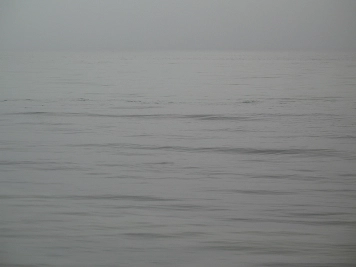
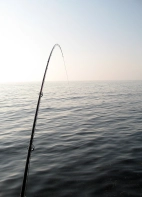
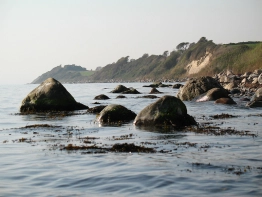
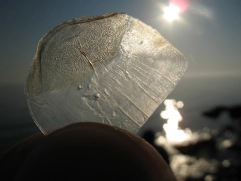
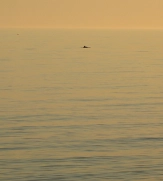
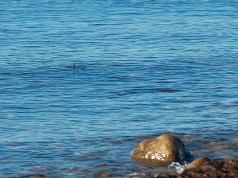

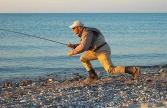
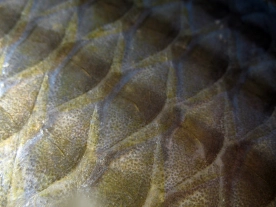


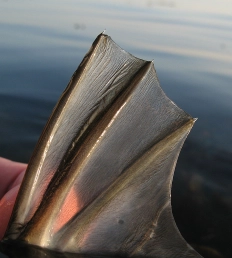
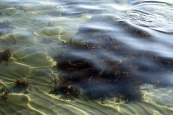
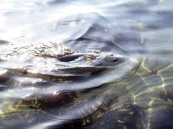

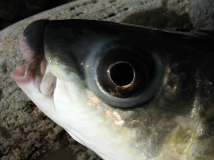
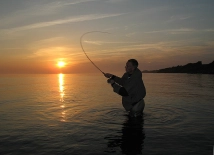

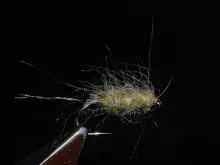
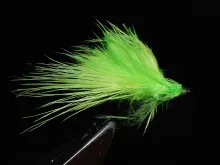
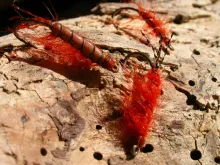
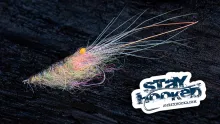
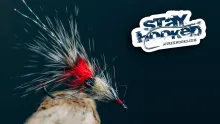


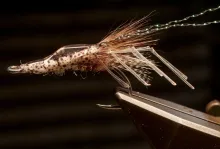
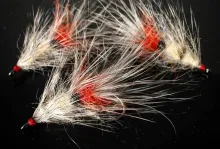

Gerard,
I am look
Gerard,
I am looking forward to reading your reports from your mullet fishing.
TL
Kasper
hi kasper looking to
hi kasper looking to know which mullet flies have you had the best success with .going to give them a try this summer gerard in ireland
Great articel! The o
Great articel! The opening paragraphs were especially appropriate as I have been standing in the middle of a large group of 'boiling' mullet this week without a single take!
You've certainly given me something to think about - thanks again!
Terrific Article I h
Terrific Article I have been catching Diamond scale mullet here in Queensland Australia on bread flies, but know the Grey ghosts (thick lipped greys) from back in Jersey in the channel islands where they where also known as poor mans bone fish as they run like a freight train when hooked in shallow water.
I would love to catch a Diamond scale mullet on some thing a bit more natural than a bread fly and will definitely try some of your patterns Thanks !
good artical, im fro
good artical, im from australia and I've been catching mullet down the beach and river for years, I just thread a bit of green or red wool on a size 14 and I'll catch a dozen in half an hour. Diffrent species though, we call them sea or bully mullet on the south east coast, great fun and the eaisest things in the world to catch (this side of the world at least!).
Tim,
congratulati
Tim,
congratulations. They are not easy.
Kasper Muhlbach
I've caught my first
I've caught my first mullet (from 75mm long up to 5lb) here in the south of England this year using white rabbit fur tied on a #10/#12 as a dropper, suspended a few inches below a white strike indicator (foam or anything that floats). After throwing in some bread to get them interested.
Hi Kasper, really ni
Hi Kasper, really nice article, I wil tie some of your flies and try these on the million mullet swimming around Biscayne Bay in Florida. I will try also the mullet shrimp for trout in my native Patagonia.
Great report Kasper
Great report Kasper ! This has wetted my appetite to try for mullet on fly, will give your selections a go this summer when i'm fishing in Devon in the UK.
Growing up in Florid
Growing up in Florida I am well acquainted with the mullet. We have both "black" and "silver" mullet.The blacks grow considerably larger but both are great table fare. I konw a lot of the older folks catch them on cane poles with corn for bait, chumming with oats or catfood.My fishing buddies and I would use castnets like you see natives in the islands.(this is legal with a 50 fish per person limit) Now that i have begun flyfishing I would love to try to take one on a fly and will let my old friends know about this "new" way of catching them.
Thank you for postin
Thank you for posting the article on mullet fishing. I live in Okinawa Japan and the Japanese fish for mullet all day using a chum bait on the China Sea. I tried several trout flies on a 7wt flyrod to catch these nice size mullet and know they would give a good fight but they swim right by them. I will try your recommendations and perhaps have better luck.
It has a long time s
It has a long time since iôve tried to cast a fly for this fish with no succes...Now, this report gave me new hope.
Here in Brazil weôve diferent mullets along the shore. In the south, 3000 km from were i am, they seem to catch on anything even a bare hook!! But here at north they are much more selective. But i think the key are small flies and a lot of tryng, again and again...
I`m from Argentina.
I`m from Argentina. My city is 1500 km from Patagonia so it isn`t very accesible go there every day, but in summer we have a lake full of mullet. I've tried to fish them on a fly but it is quite imposible. Fishers cath them only with cow heart as bait!!!! Only red colours foll this fish. I`ve trie with red flies but i have no answers. What fly do you recomend me???I`m going crazy!!!!
JS,
have you had
JS,
have you had any success yet?
Kasper
It is nice fish, but
It is nice fish, but have not have any image you can get mullet in Scandinavia.
I through this fish lives in much warmer water, as we have quite a lot in Tokyo and Yokohama.
By the way, if possible, could you recommend me a spot of Seatrout?
I am going to Murrum next week and if I have time I would like to try some Seatrout fishing at the sea on the way from Copenhagen to Murrum.
Great fishing and ar
Great fishing and article but have not have any image Mullets at the Scandinavia.
We have may Mullets in our River and Bay, use small flys with indicator.
Very easy access from my home approx within 10min, but you can catch close to 10lbs.
Mr. Joergensen, we h
Mr. Joergensen, we have also mullets in Argentina. Anadromous fish, extremelly fifficult to catch. We are just a few anglers that are trying to fool them on flies. Normal mullets are 5 pounders and usual big ones in some big salty lagoons connected to the Atlantic, reach 6-7 kilos (13-16 lbs).
Beautiful fish, grea
Beautiful fish, great reading. Really very nice :)
nice article overall
nice article overall but the qote "and soon we were in the suit that suits us the best" is one of the greatest i've read.